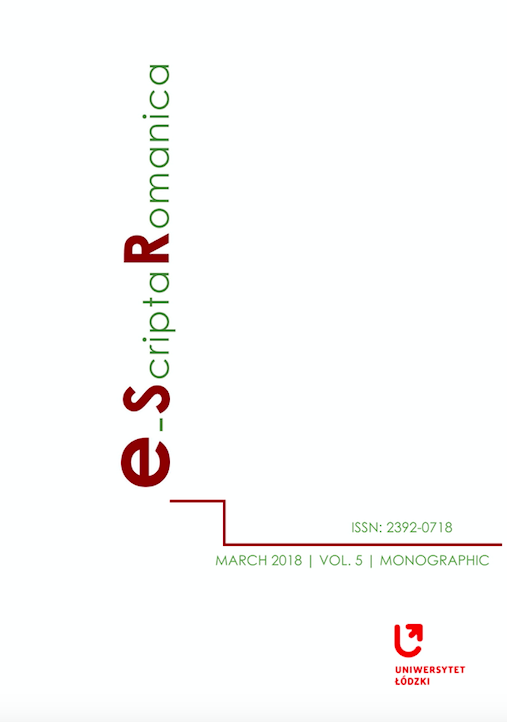Frecuencia léxica y secuenciación del vocabulario en lecturas graduadas del español
DOI:
https://doi.org/10.18778/2392-0718.05.05Parole chiave:
nivelación del vocabulario, nivelación de colocaciones, frecuencia léxicaAbstract
El presente artículo estudia la distribución de palabras y colocaciones presentes en un corpus de lecturas graduadas del español a través de los distintos niveles de aprendizaje. El objetivo principal es verificar si se da una correlación entre la frecuencia léxica tal como se registra en un corpus del español general y la distribución de los elementos del vocabulario (formas univerbales y pluriverbales) en textos de diferente nivel, de manera que los elementos infrecuentes sean más numerosos conforme el nivel sube. Esta correlación no se puede dar por supuesta en las lecturas graduadas en español, pues un repaso a la bibliografía relevante indica que se ha dado prioridad a factores distintos a la selección del vocabulario en la creación de este tipo de materiales (en concreto, al componente gramatical).
Riferimenti bibliografici
ALONSO RAMOS, M. (2012): “Explorando la frecuencia léxica para el Diccionario de colocaciones del español”. Cum corde et in nova grammatica: Estudios ofrecidos a Guillermo Rojo. T. JIMÉNEZ JULIÁ, B. LÓPEZ MEIRAMA, V. VÁZQUEZ ROZAS Y A. VEIGA (eds.). Santiago de Compostela: Universidade de Santiago de Compostela, pp. 19–40.
Google Scholar
BÁEZ MONTERO, I. Y B. SUÁREZ RODRÍGUEZ (2011): “Lectura analógica / lectura digital : ‘el papel’ de las lecturas graduadas en aprendices de E / LE”. La Red y sus aplicaciones en la enseñanza-aprendizaje del español como lengua extranjera. C. HERNÁNDEZ GONZÁLEZ, A. CARRASCO SANTANA Y E. ÁLVAREZ RAMOS (eds.). Valladolid: ASELE, pp. 117–128.
Google Scholar
BESTGEN, Y. (2014): “Inadequacy of the chi-squared test to examine vocabulary differences between corpora”. Literary and Linguistic Computing, 29,2, pp. 164–170.
Google Scholar
BIBER, D. (1993): “Representativeness in Corpus Design”. Literary and Linguistic Computing, 8,4, pp. 243–257.
Google Scholar
BOGAARDS, P. (2001): “Lexical Units and the Learning of Foreign Language Vocabulary”. Studies in Second Language Acquisition 23,3, pp. 321–343.
Google Scholar
CROSSLEY, S., T. SALSBURY, A. TITAK & D. MCNAMARA (2014): “Frequency effects and second language lexical acquisition: Word types, word tokens, and word production”. International Journal of Corpus Linguistics, 19, pp. 301–332.
Google Scholar
CRUSE, D. A. (1986): Lexical Semantics. Cambridge: Cambridge University Press.
Google Scholar
DURRANT, P. (2009): “Investigating the viability of a collocation list for students of English for academic purposes”. English for Specific Purposes, 28,3, pp. 157–169.
Google Scholar
FERRANDO ARAMO, V. (2012): Aspectos teóricos y metodológicos para la compilación de un diccionario combinatorio destinado a estudiantes de E/LE. Tesis doctoral. Universitat Rovira i Virgili.
Google Scholar
GÓMEZ MOLINA, J. R. (2004): “Los contenidos léxico-semánticos”. Vademécum para la formación de profesores. J. SÁNCHEZ LOBATO E I. SANTOS GARGALLO (dirs.): Madrid: SGEL, pp. 789–810.
Google Scholar
GONZÁLEZ FERNÁNDEZ, B. Y N. SCHMITT (2015): “How much collocation knowledge do L2 learners have? The effects of frequency and amount of exposure”. ITL - International Journal of Applied Linguistics, 166,1, pp. 94–126.
Google Scholar
HIGUERAS, M. (2006): Las colocaciones y su enseñanza en la clase de ELE. Madrid: Arco Libros.
Google Scholar
IZQUIERDO, M. C. (2004): La seleccion del léxico en la enseñanza del español como lengua extranjera. Su aplicacion en el nivel elemental en estudiantes francófonos. Tesis doctoral. Universitat de València.
Google Scholar
LAUFER, B. Y P. NATION (1995): “Vocabulary Size and Use: Lexical Richness in L2 Written Production”. Applied Linguistics, 16,3, pp. 307-322.
Google Scholar
MARTINEZ, R. (2013): “A framework for the inclusion of multi-word expressions in ELT”. ELT Journal, 67, pp. 184–198.
Google Scholar
MEL’ČUK, I. (1996): “Lexical Functions: A Tool for the Description of Lexical Relations in the Lexicon”. Lexical Functions in Lexicography and Natural Language Processing. L. WANNER (ed.). Amsterdam/Philadelphia: John Benjamins, pp. 37–102.
Google Scholar
MEL’ČUK, I (2012): “Phraseology in the language, in the dictionary, and in the computer”. Yearbook of Phraseology, 3, pp. 31–56.
Google Scholar
MEL’ČUK, I (2015): “Clichés, an understudied class of phrasemes”. Yearbook of Phraseology, 6(1), pp. 35–54
Google Scholar
MEL’ČUK, I., A. CLAS Y A. POLGUERE (1995) : Introduction à la lexicologie explicative et combinatoire. Louvain-la-Neuve: Duculot.
Google Scholar
NATION, P. (2001): Learning vocabulary in another language. Cambridge: Cambridge University Press.
Google Scholar
OAKES, M. P. Y M. FARROW (2007): “Use of the chi-squared test to examine vocabulary differences in English language corpora representing seven different countries”. Literary and Linguistic Computing, 22,1, pp. 85–99.
Google Scholar
READ, J. (2000): Assessing Vocabulary. Cambridge: Cambridge University Press.
Google Scholar
SÁNCHEZ, A. (2001): Gran Diccionario de Uso del español actual. Madrid: SGEL.
Google Scholar
SÁNCHEZ, A. & P. CANTOS-GÓMEZ (1997): “Predictability of Word Forms (Types) and Lemmas in Linguistic Corpora. A Case Study Based on the Analysis of the CUMBRE Corpus : An 8-Million-Word Corpus of Contemporary Spanish”. International Journal of Corpus Linguistics, 2,2, pp. 259–280.
Google Scholar
SINCLAIR, J. M. (1991): Corpus, Concordance, Collocation. Oxford: Oxford University Press.
Google Scholar
SINCLAIR, J. M. Y A. RENOUF (1985): “A lexical learning syllabus for language”. Vocabulary and Language Teaching. C. RONALD & M. MCCARTHY (eds.). London; New York: Longman, pp. 140–160.
Google Scholar
VAN HEUVEN, W. J. B., P. MANDERA, E. KEULEERS & M. BRYSBAERT (2014): “Subtlex-UK: A new and improved word frequency database for British English”. Quarterly Journal of Experimental Psychology, 67, pp. 1176–1190.
Google Scholar
VINCZE, O. Y M. ALONSO RAMOS (2013): “Incorporating Frequency Information in a Collocation Dictionary: Establishing a Methodology”. Procedia - Social and Behavioral Sciences, 95, pp. 241–248.
Google Scholar
ANTHONY, L. (2014): AntWordProfiler (Version 1.4.1). Tokyo: Waseda University. <http://www.laurenceanthony.net/>
Google Scholar
INSTITUTO CERVANTES (1997-2015): Plan curricular del Instituto Cervantes. Niveles de referencia para el español. <http://cvc.cervantes.es/ensenanza/biblioteca_ele/plan_curricular/>.
Google Scholar
INSTITUTO CERVANTES (2000-2015): Lecturas paso a paso. <http://cvc.cervantes.es/aula/lecturas/>
Google Scholar
REAL ACADEMIA ESPAÑOLA (s.f.): Corpus de Referencia del Español Actual (CREA). <http://corpus.rae.es/creanet.html>
Google Scholar
SAN MATEO VALDEHÍTA, A. (2005): Una lectura graduada narrativa para estudiantes de ELE de nivel avanzado. Tesis de máster. http://www.mecd.gob.es/redele/Biblioteca-Virtual/2005/memoriaMaster/1-Semestre/SAN-MATEO-UCM.html
Google Scholar
Downloads
Pubblicato
Come citare
Fascicolo
Sezione
Licenza

Questo lavoro è fornito con la licenza Creative Commons Attribuzione - Non commerciale - Non opere derivate 4.0 Internazionale.











